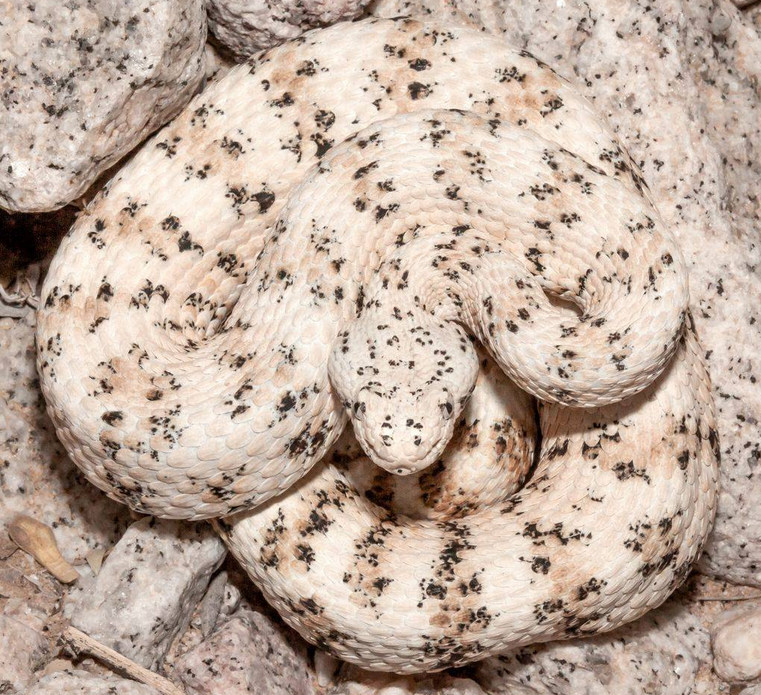If there’s one thing worse than actually seeing a rattlesnake, it’s not seeing it and knowing it’s there! Many venomous rattlesnakes are experts at blending into their environment — it’s something wildlife officials and snake removal experts in Arizona see quite often — rattlesnakes that hide in plain sight.
The southwestern speckled rattlesnake from central Arizona is rarely seen by most people because of it's excellent camouflage. In the mountains of southern Yavapai County, the area is covered with rough granite boulders of the same base color as the snake— some pinkish/orange, some black and  white. There is even a light blue rattlesnake, and you might be surprised to learn this is one of the most common rattlesnake species in the Phoenix area. Each community of southwestern speckled rattlesnakes is born with an adaptation that makes it look almost exactly like the rock composition in its immediate area. To see one in motion is to see what appears to be moving rocks, experts say. Even down to the smallest detail of the eye and the flecking frequency within the rock, the disguise is complete. This makes them both incredibly specialized predators, and notoriously difficult for humans or dogs to spot and then avoid. In the right context, the speckled rattlesnake is nearly invisible to passersby. According to the Tuscon Herpetology Society, this species is found in Arizona, southern California, southern Nevada, and extreme southwestern Utah. Every mountain from Phoenix to the Pacific Ocean has its own unique color combination of southwestern speckled rattlesnakes. Whether you appreciate snakes or they all give you the willies, there’s no denying their impressive camouflage ability.
white. There is even a light blue rattlesnake, and you might be surprised to learn this is one of the most common rattlesnake species in the Phoenix area. Each community of southwestern speckled rattlesnakes is born with an adaptation that makes it look almost exactly like the rock composition in its immediate area. To see one in motion is to see what appears to be moving rocks, experts say. Even down to the smallest detail of the eye and the flecking frequency within the rock, the disguise is complete. This makes them both incredibly specialized predators, and notoriously difficult for humans or dogs to spot and then avoid. In the right context, the speckled rattlesnake is nearly invisible to passersby. According to the Tuscon Herpetology Society, this species is found in Arizona, southern California, southern Nevada, and extreme southwestern Utah. Every mountain from Phoenix to the Pacific Ocean has its own unique color combination of southwestern speckled rattlesnakes. Whether you appreciate snakes or they all give you the willies, there’s no denying their impressive camouflage ability.
Encountering a rattlesnake while out hiking or working outdoors is fairly common, but something that’s should not be common is finding a viper hiking under your bed! Yikes! That’s a lot worse than thinking the boogie man lives under there! Recently, a couple in Phoenix were surprised by a big Western Diamondback Rattlesnake. It was nearly 5 feet long — very large for the state of Arizona — and in a “defensive” state of mind. How did it get there? The best guess is that in came in through an open door. The tenant went out onto the patio for a few minutes, left the door open, and then saw it after going back inside from the patio. Only 1 in 400 calls to a rattlesnake removal company proves to be a rattlesnake in a home, showing how rarely it happens. In most of those cases, the rattlesnake got in through an open door. This was safely removed by an expert and good thing, too, because a Western diamondback is one of the nation’s 10 most dangerous snakes, with a venom that causes massive internal bleeding.
Obviously, prevention and avoidance is the way to go when it comes to snakes. So here’s a tip…. don’t plant Lantana around your home. This plant, which is installed at most new builds in Arizona by default, is the most rattlesnake-friendly landscaping feature you can have. If you have it, and live where rattlesnakes do, consider carefully how much you like this type of verbena. Prevention is key. Killing a snake does nothing to prevent future encounters. But not “inviting” snakes in the first place is the way to go. Besides growing lantana, having wood piles, sources of moisture, and rodents can inadvertently “invite” snakes into your yard, too.
If you purposely go out into snake country to hike, bike, camp, or if you work outdoors, don’t take a chance! Snake Gaiters can offer peace of mind and help protect your lower legs from deadly snake fangs.